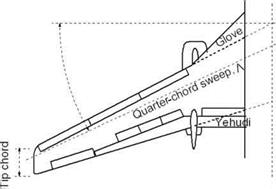Wing Definitions
This section defines the parameters used in wing design and explains their role. The parameters are the wing planform area (also known as the wing reference area, SW); wing-sweep angle, Л; and wing taper ratio, X (dihedral and twist angles are given after the reference area is established). Also, the reference area generally does not include any extension area at the leading and trailing edges. Reference areas are concerned with the projected rectangular/trapezoidal area of the wing.
3.7.2 Planform Area, Sw
The wing planform area acts as a reference area for computational purposes. The wing planform reference area is the projected area, including the area buried in the fuselage shown as a dashed line in Figure 3.30. However, the definition of the wing planform area differs among manufacturers. In commercial transport aircraft design, there are primarily two types of definitions practiced (in general) on either side of the Atlantic. The difference in planform area definition is irrelevant as long as the type is known and adhered to. This book uses the first type (Figure 3.30a), which is prevalent in the United States and has straight edges extending to the fuselage centerline. Some European definitions show the part buried inside the fuselage
Figure 3.31. Wing geometry definition (Boeing 737 half wing)
![]()
 as a rectangle (Figure 3.30b); that is, the edges are not straight up to centerline unless it is a rectangular wing normal to the centerline. Section 4.8 describes the various options available from which to choose a wing planform.
as a rectangle (Figure 3.30b); that is, the edges are not straight up to centerline unless it is a rectangular wing normal to the centerline. Section 4.8 describes the various options available from which to choose a wing planform.
A typical subsonic commercial transport-type wing is shown in Figure 3.31. An extension at the LE of the wing root is called a glove and an extension at the trailing edge is called a yehudi (this is Boeing terminology). The yehudi’s low-sweep trailing edge offers better flap characteristics. These extensions can originate in the baseline design or on the existing platform to accommodate a larger wing area. A glove and/or a yehudi can be added later as modifications; however, this is not easy because the aerofoil geometry would be affected.











